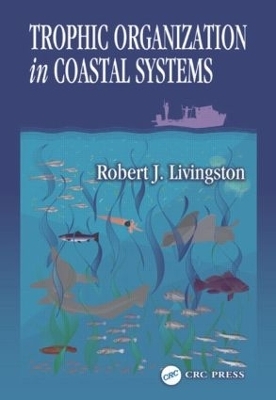
Trophic Organization in Coastal Systems
Seiten
2002
Crc Press Inc (Verlag)
978-0-8493-1110-9 (ISBN)
Crc Press Inc (Verlag)
978-0-8493-1110-9 (ISBN)
Explores an alternative approach to coastal research that has been applied to coastal resource management issues. Based upon a sequence of long-term, interdisciplinary studies of a series of coastal regions in the NE Gulf of Mexico, this book advances the readers' understanding of how coastal food webs work.
Derived from an unprecedented research effort covering over 70 field years of field data in a series of studies, Trophic Organization in Coastal Systems represents an alternative approach to coastal research that has been successfully applied to coastal resource management issues. This unique book is based upon a sequence of long-term, interdisciplinary studies of a series of coastal regions in the NE Gulf of Mexico that include nutrient loading, habitat definition, quantified collections of organisms from microbes to fishes, and the determination of the trophic organization that defines the processes that shape the productivity of these areas.
A multidisciplinary team of marine scientists, chemists, physical oceanographers, geologists, hydrologists, engineers, experimental biologists, and taxonomists have created a singular database of changes in a series of Gulf of Mexico coastal systems. This field information, together with field and laboratory experimentation, is integrated with the scientific literature to advance our understanding of how coastal food webs work. The central focus is on the relationship of primary production in the form of species-specific phytoplankton communities with associated food webs of coastal systems and the relationship of tropho-dynamic processes to long-term changes (natural and polluted) in such areas. The impacts of phytoplankton blooms on trophic organization is elucidated.
The author, a renowned marine scientist, provides detailed knowledge of the processes that drive coastal ecosystems. He presents an in-depth discussion of a hierarchy of cyclical periods associated with the formation and development of aquatic food webs. Trophic Organization in Coastal Systems will be particularly useful to those involved in research related to the importance of aquatic food webs to an understanding of how aquatic systems function. The principles and processes of trophic organization presented here can serve as a valuable model for research in other regions of the world.
Derived from an unprecedented research effort covering over 70 field years of field data in a series of studies, Trophic Organization in Coastal Systems represents an alternative approach to coastal research that has been successfully applied to coastal resource management issues. This unique book is based upon a sequence of long-term, interdisciplinary studies of a series of coastal regions in the NE Gulf of Mexico that include nutrient loading, habitat definition, quantified collections of organisms from microbes to fishes, and the determination of the trophic organization that defines the processes that shape the productivity of these areas.
A multidisciplinary team of marine scientists, chemists, physical oceanographers, geologists, hydrologists, engineers, experimental biologists, and taxonomists have created a singular database of changes in a series of Gulf of Mexico coastal systems. This field information, together with field and laboratory experimentation, is integrated with the scientific literature to advance our understanding of how coastal food webs work. The central focus is on the relationship of primary production in the form of species-specific phytoplankton communities with associated food webs of coastal systems and the relationship of tropho-dynamic processes to long-term changes (natural and polluted) in such areas. The impacts of phytoplankton blooms on trophic organization is elucidated.
The author, a renowned marine scientist, provides detailed knowledge of the processes that drive coastal ecosystems. He presents an in-depth discussion of a hierarchy of cyclical periods associated with the formation and development of aquatic food webs. Trophic Organization in Coastal Systems will be particularly useful to those involved in research related to the importance of aquatic food webs to an understanding of how aquatic systems function. The principles and processes of trophic organization presented here can serve as a valuable model for research in other regions of the world.
Robert J. Livingston
Introduction. The Northeast Gulf of Mexico. Long-Term Studies in The NE Gulf of Mexico. Trophic Organization in Gulf Coastal Systems. Structural Components of Trophic Organization. Coastal Phytoplankton Organization. Food Web Response to Plankton Blooms. Comparative Aspects of Trophic Organization. Regulation and Food Web Factors. Trophic Organization and Resource Management. Ecosystem Studies: Approaches and Methods. Conclusions. Summary of Results. References. Appendices Index.
| Erscheint lt. Verlag | 23.12.2002 |
|---|---|
| Reihe/Serie | CRC Marine Science |
| Zusatzinfo | 30 Tables, black and white; 25 Halftones, black and white; 124 Illustrations, black and white |
| Verlagsort | Bosa Roca |
| Sprache | englisch |
| Maße | 178 x 254 mm |
| Gewicht | 930 g |
| Themenwelt | Naturwissenschaften ► Biologie ► Biochemie |
| Naturwissenschaften ► Biologie ► Limnologie / Meeresbiologie | |
| Naturwissenschaften ► Biologie ► Ökologie / Naturschutz | |
| Naturwissenschaften ► Geowissenschaften ► Geografie / Kartografie | |
| Weitere Fachgebiete ► Land- / Forstwirtschaft / Fischerei | |
| ISBN-10 | 0-8493-1110-1 / 0849311101 |
| ISBN-13 | 978-0-8493-1110-9 / 9780849311109 |
| Zustand | Neuware |
| Haben Sie eine Frage zum Produkt? |
Mehr entdecken
aus dem Bereich
aus dem Bereich


